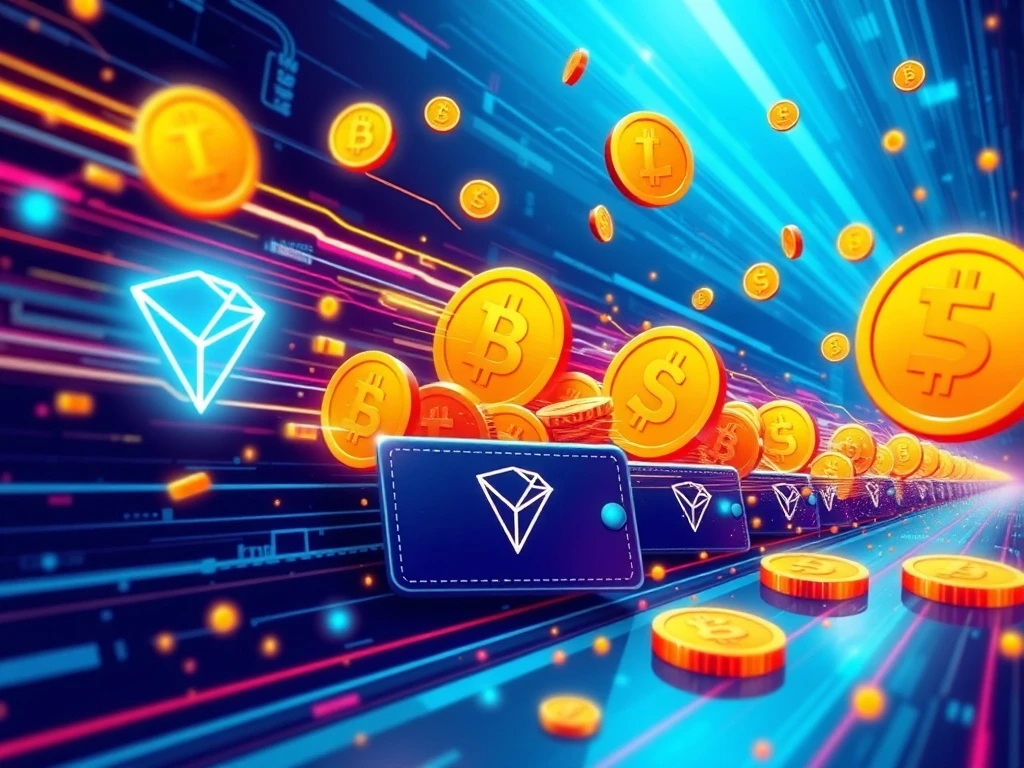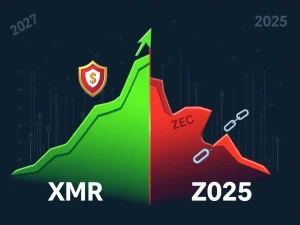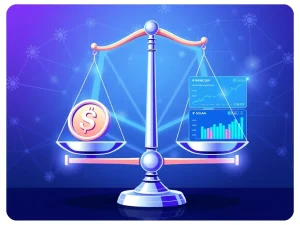TRON Stablecoin Transactions: Explosive 11.6% Surge Signals a New Era for P2P Stablecoin Payments

In the dynamic world of cryptocurrencies, a quiet revolution is unfolding, one that’s reshaping how we think about digital money transfers. At the forefront of this transformation is the TRON network, which has emerged as an undisputed leader in peer-to-peer (P2P) stablecoin transactions. If you’re invested in the future of digital finance, the latest figures on TRON stablecoin transactions offer compelling insights into the growing preference for decentralized, efficient transfers.
TRON Stablecoin Transactions: A Paradigm Shift in Digital Payments
The latest data paints a clear picture: TRON’s blockchain network is rapidly solidifying its position as a dominant force in stablecoin transfers. A staggering 70% of USDT transactions on the network now occur directly between wallets, bypassing centralized exchanges entirely. This isn’t just a minor shift; it represents a significant move towards true decentralization in everyday digital payments. This preference for direct, wallet-to-wallet transfers underscores a growing demand for low-cost, high-speed solutions, a hallmark of TRON’s robust infrastructure.
The numbers speak for themselves:
- Q2 2025 USDT Volume: $21.3 billion, an impressive 11.6% increase quarter-on-quarter.
- Average Daily Transactions: Climbed to 7.7 million, marking a 12.6% rise in the same period.
- Daily USDT Transaction Count: TRON now handles between 2.3–2.4 million daily USDT transactions, outpacing Ethereum by a factor of 6.8 [2].
This remarkable growth in TRON stablecoin transactions highlights the network’s technical advantages, particularly its TRC-20 token standard, which ensures faster settlement times and significantly lower fees compared to many competing blockchains.
Understanding the P2P Stablecoin Surge
What’s driving this P2P stablecoin surge? It boils down to efficiency and user demand. Users are increasingly seeking alternatives to congested networks like Ethereum, where high transaction costs and delays can make microtransactions and everyday usage impractical. TRON’s early optimization for stablecoin transfers allowed its ecosystem to scale organically, perfectly aligning with the increasing demand for direct, peer-to-peer activity [3].
The surge in wallet-to-wallet activity has led to a tripling of daily P2P volume since 2023. This isn’t just about speculative trading; it’s about real-world utility. USDT on TRON is increasingly serving as a medium of exchange for:
- Remittances across borders
- Informal commerce
- Cross-border settlements
This trend aligns with TRON’s broader vision of decentralizing financial systems, empowering users to bypass traditional banking infrastructure and take control of their assets.
Why USDT on TRON Leads the Pack
The dominance of USDT on TRON is a testament to the network’s design. The TRC-20 standard for USDT ensures transactions are not only fast but also incredibly cost-effective. This efficiency has made TRON the go-to network for users who prioritize practicality over high fees. While Ethereum remains a cornerstone for many DeFi applications, TRON has carved out a distinct niche for high-volume, low-value stablecoin transfers, demonstrating its superior capacity in this specific area.
For instance, significant capital movements, such as the withdrawal of $646 million in ETH from Aave by TRON co-founder Justin Sun and other stakeholders, illustrate a strong confidence in the network’s scalability and cost-effectiveness [4]. Such actions, combined with the rising P2P activity, suggest a strategic reallocation of assets within the broader TRON ecosystem, signaling its growing importance in the crypto landscape.
TRON Network Growth: Beyond Speculation
The consistent quarter-on-quarter TRON network growth without major setbacks demonstrates robust adoption and resilience. The network’s ability to handle high throughput, averaging 7.7 million daily USDT transactions, further reinforces its capacity to meet expanding demand [1]. This isn’t merely about hype; it’s about a blockchain proving its mettle in real-world scenarios, offering a reliable and scalable solution for digital payments.
The evolution of stablecoins on TRON also reflects a broader industry shift towards utility-driven use cases. By reducing intermediaries, users can leverage TRON’s infrastructure to transact directly, bypassing traditional financial systems. This aligns perfectly with the network’s mission to create a truly decentralized financial ecosystem where low barriers to entry and high throughput enable global participation.
Empowering Decentralized Finance with TRON
TRON’s strategic focus on practical applications for stablecoins is positioning it as a key player in the future of decentralized finance. While challenges remain, particularly concerns about the network’s reliance on a single blockchain for a majority of USDT transactions and potential regulatory pressures, TRON’s performance metrics suggest a robust and resilient platform. Its consistent growth and proven ability to handle massive transaction volumes indicate strong user adoption and confidence.
As stablecoin adoption accelerates globally, TRON’s emphasis on practical, everyday transactions—rather than purely speculative activity—may solidify its position as a leading blockchain for real-world utility. It offers a glimpse into a future where financial interactions are more direct, affordable, and accessible to everyone.
The ongoing surge in P2P stablecoin transactions on TRON is more than just a statistic; it’s a clear indicator of a maturing blockchain ecosystem. With its focus on efficiency, low costs, and a growing DeFi landscape, TRON is not just competing but actively setting new benchmarks for how digital assets can facilitate global commerce and financial inclusion. As users increasingly seek alternatives to traditional financial bottlenecks, TRON stands ready to deliver a decentralized, high-performance solution.
Frequently Asked Questions (FAQs)
Q1: What is driving the surge in TRON’s P2P stablecoin transactions?
The surge is primarily driven by TRON’s low transaction fees, high speed, and the efficiency of its TRC-20 token standard. These factors make direct wallet-to-wallet stablecoin transfers significantly more cost-effective and faster compared to other networks, attracting users seeking practical solutions for remittances, commerce, and daily transactions.
Q2: How does TRON’s stablecoin transaction volume compare to Ethereum’s?
TRON’s daily USDT transaction count, ranging between 2.3–2.4 million, significantly outpaces Ethereum by a factor of 6.8. This highlights TRON’s dominance in handling high volumes of stablecoin transfers efficiently.
Q3: What role does TRON’s DeFi ecosystem play in this growth?
TRON’s expanding decentralized finance (DeFi) ecosystem plays a pivotal role by providing a robust environment for stablecoin usage. It offers various applications and services that integrate stablecoins, encouraging more users to engage with direct, P2P transactions within the network.
Q4: Are there any challenges or concerns regarding TRON’s stablecoin dominance?
Some critics caution about the network’s reliance on a single blockchain for a majority of USDT transactions, which could potentially introduce vulnerabilities if regulatory pressures or technical disruptions arise. However, TRON’s consistent quarter-on-quarter growth and robust performance metrics suggest strong resilience and adoption.
Q5: How does TRON contribute to the broader vision of decentralized finance?
TRON contributes to decentralized finance by enabling users to bypass traditional banking infrastructure through direct, low-cost, and high-speed stablecoin transactions. This aligns with its mission to create a decentralized financial ecosystem that offers low barriers to entry and high throughput, fostering global participation and financial inclusion.









